The Complete Guide to Hootsuite Alternatives: 13 Tools Compared (2025)
Discover Hootsuite alternatives that can help with budget optimization: Explore features, pricing, and user reviews to find your perfect fit.


If you’ve ever hit a wall because your current social tool won’t give you proper competitor benchmarks, or forces you into clunky manual screenshots just to build a report, you’re not alone. Many teams don’t go hunting for Hootsuite alternatives because Hootsuite “doesn’t work,” but because it leaves critical gaps that slow down reporting and hurt credibility with clients and stakeholders.
The issue isn’t whether Hootsuite works, but whether it delivers enough value to justify its price (e.g., paying over $500 a month for a five-person team to manage just five social accounts with basic reporting) as compared to its other capable competitors.
In this article, I cover 13+ Hootsuite alternatives, with side-by-side comparisons, pricing, and feature breakdowns to help you decide when to stick, switch, or scale smarter.
Key takeaways
-
Many teams look for Hootsuite alternatives because of its steep pricing, and limited analytics depth.
-
The best alternatives vary by need, ex: Socialinsider for advanced analytics, Later for visual content, Agorapulse for agencies.
-
Migrating from Hootsuite is manageable with a structured plan that includes auditing accounts, exporting data, training teams, and phasing in the new tool.
Why look for Hootsuite alternatives?
High pricing, especially for teams
- The standard plan costs $99 per user per month, and that’s for just five social accounts, basic analytics reports, and brand + competitor mention data for 7 days. For a 5-member marketing team, that’s over $500/month just to access entry-level features.
- To unlock team approval features, support for unlimited accounts, and advanced analytics, you have to upgrade to the advanced plan at $249 per user per month. That’s almost $15,000 per year for a 5-person team.
- One G2 user summed it up: “The fact is, there were features we were promised when we signed our 3-year agreement that never came to fruition. Promises were made by the customer service department that they could not keep and never happened.”
- In contrast, Buffer’s team plan offers unlimited accounts, unlimited users, advanced analytics, first comment scheduling, and content approval workflows for $10/month. SocialPilot offers similar team features at just $50/month.
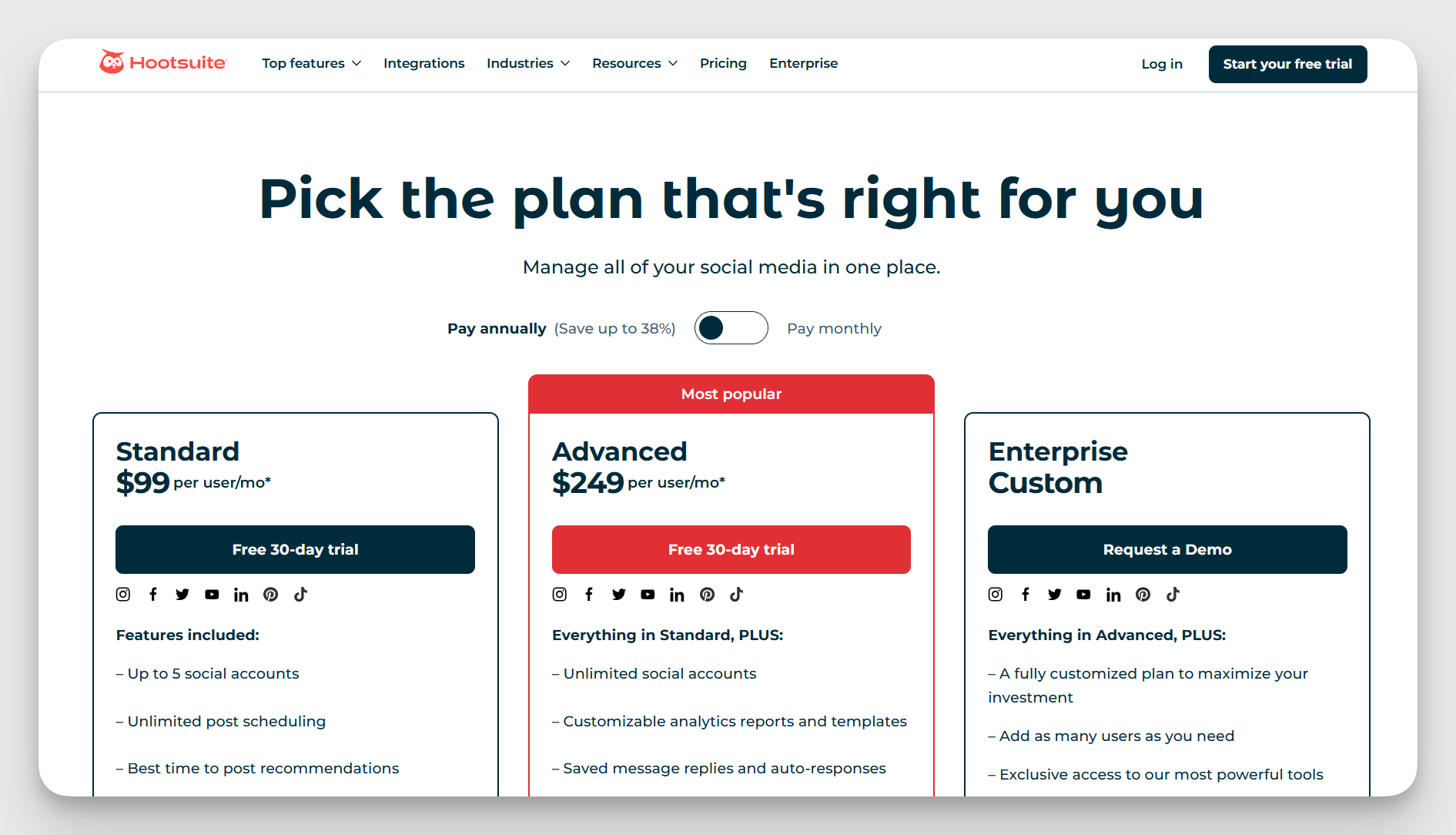
Lack of in-depth analytics
- Hootsuite’s analytics dashboard may look sleek and visually appealing, but the depth of the data leaves much to be desired–and sometimes it’s just plain wrong. Multiple users on G2 have flagged inaccuracies in its analytics reports.
- When you can’t fully trust the data you’re getting, making informed, data-driven decisions becomes pretty challenging.
- Compared to the in-depth, channel-specific analytics available natively (or even in competing tools like Socialinsider), Hootsuite’s offering feels surface-level and outdated.
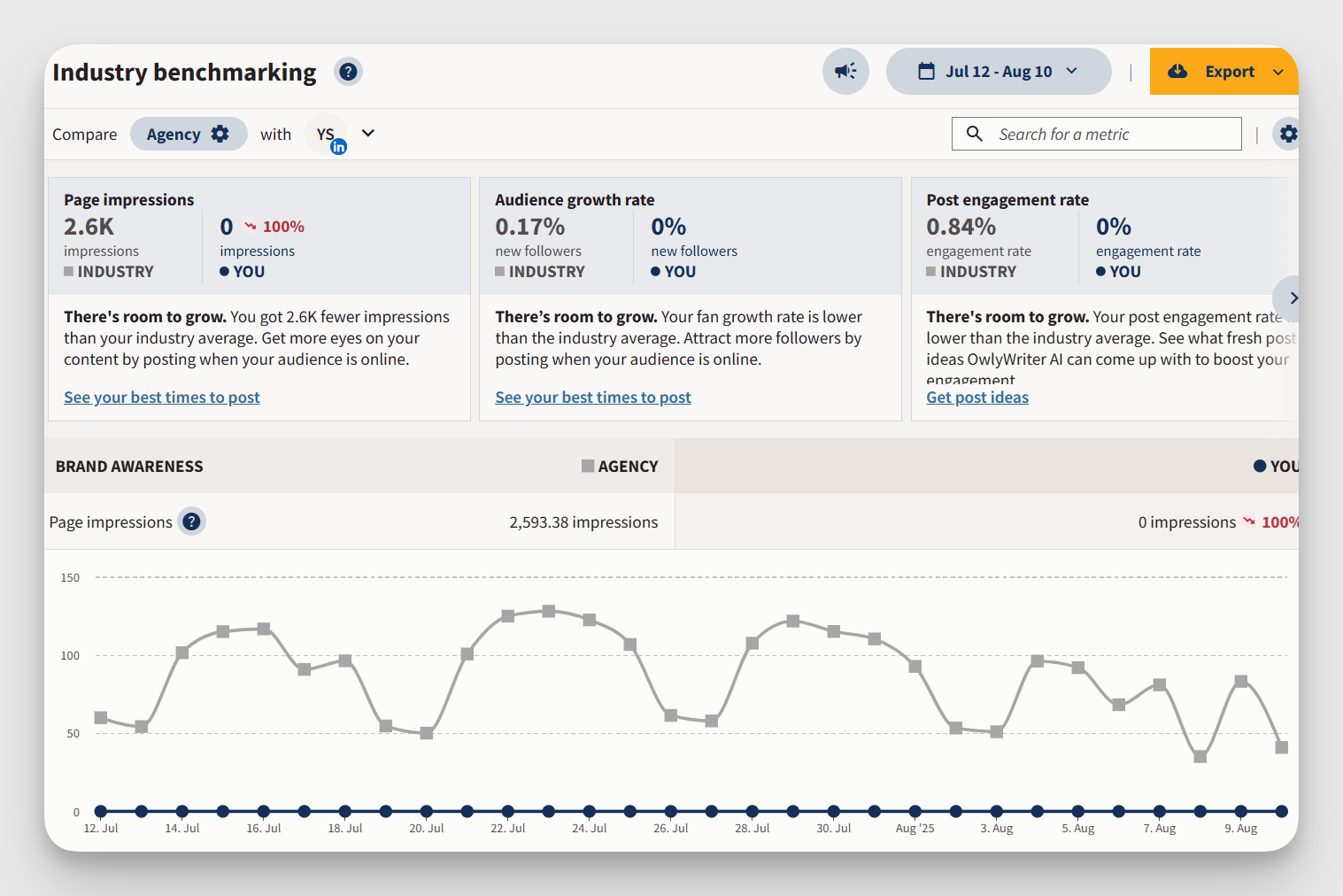
Clunky, outdated interface
- According to users, the interface feels overly busy and clumsy, which makes navigation difficult.
- While Hootsuite offers some useful integrations like Dropbox and Google Drive, finding and using them isn’t as straightforward as it should be. For example, locating app integrations requires multiple steps: Dashboard → Plan → Content tab → Explore apps.
- I also found that the platform often lags and takes time to load, adding unnecessary friction to routine tasks.
Feature gaps and platform limitations
- There’s no true TikTok integration. Hootsuite only sends manual post reminders instead of publishing directly.
- One G2 reviewer also pointed out that adding more than one image to a post is clunky. There’s no gallery or slideshow feature either.
- The Inbox tool, which centralizes comments and messages, is available across all plans, but inbox reporting and search features are locked behind higher-tier plans.
- Beyond posting features, Hootsuite is also missing key capabilities like content tagging and segmentation, more in-depth analytics and reporting, content pillars analysis, and the ability to measure organic ROI of social media content.
- Some teams also find that the real “deal breaker” isn’t just the interface or price, but missing coverage for critical platforms. For example, marketers have had to move away from other tools when they realized TikTok or YouTube competitive bechmarks weren’t supported at all, or when regional API limitations meant they couldn’t get the TikTok data they needed for competitive reports.
If Hootsuite ever creates similar gaps in your stack, it can quickly undermine your ability to deliver reliable, cross-channel insights.
Support and reliability concerns
G2 reviewers have reported frequent disconnections and issues with customer support, with some stating that the customer service can take weeks to give a response.
What a modern alternative to Hootsuite should offer?
A strong Hootsuite alternative should fix the main issues of the tool and fill in its feature gaps.
- Pricing should be transparent, predictable, and scalable without any sudden hikes.
- Analytics need to be accurate and advanced, with tagging and categorization to give marketers deeper, more actionable insights, plus reliable competitor benchmarking so you can report on your performance in the context of your market—not just your own feeds.
- The interface should be fast, clean, and intuitive
- Full-feature support should extend across all major platforms, including TikTok, Instagram, YouTube, and Threads; for many teams, switching tools is triggered exactly when a key channel is missing or only partially supported, so full coverage for your priority platforms is non-negotiable.
- Reliability should be a given. Account connections must remain stable, with real-time alerts sent out the moment something goes wrong.
- Support must be fast and responsive across all plan tiers.
When it makes sense to switch vs. stay
Consider switching if:
- You're scaling beyond one user or multiple social profiles, and the pricing will soon exceed your budget.
- Accurate and detailed analytics are critical to your business
- Your team relies on collaborative workflows, approvals, and a clean UI
- Hootsuite’s clunkiness and low reliability have already cost you time and money
- Support responsiveness and platform reliability matter to you
Staying may make sense if:
- Your needs are simple, like solo scheduling and posting on a few profiles.
- You don’t need in-depth analytics.
- You're happy with existing workflows and interface.
How we evaluated these Hootsuite alternatives?
We tested each tool hands-on, compared features side-by-side, and reviewed third-party feedback from platforms like G2 and Reddit communities.
Our evaluation criteria include:
- Analytics and reporting depth
- Ease of use and interface design
- Customer support quality
- Scheduling and publishing capabilities
- Team collaboration features
- Integration ecosystem
- Pricing and value proposition
- Platform coverage and limitations
Quick comparison: Top Hootsuite alternatives at a glance
Detailed reviews: 13 Hootsuite alternatives
Analytics and intelligence powerhouses
1. Socialinsider
Socialinsider is an AI-driven social media analytics tool built for marketers who need more than Hootsuite’s basic reporting. It lets you analyze your own social media performance or track competitors’ accounts in detail. You can benchmark results against direct competitors or industry standards.
It’s ideal for agencies, enterprises, and data-driven marketing teams that must back their strategies with credible insights.
Here are the top features of Socialinsider:
- Premium social media analytics: Provides detailed metrics for all major platforms, including engagement trends, reach, impressions, follower growth, and content performance over extended timeframes. It also supports post-level historical tracking (with extended access available on request).
- Competitor analysis and industry insights: Tracks competitor performance and helps you compare their metrics side-by-side. It also lets you identify your top-performing posts, posting frequency, and audience engagement patterns to find gaps in their strategy.

- Benchmark capabilities: You can benchmark your social media performance against competitors, industry averages, or specific market segments to understand whether your results are above, at, or below market standards.
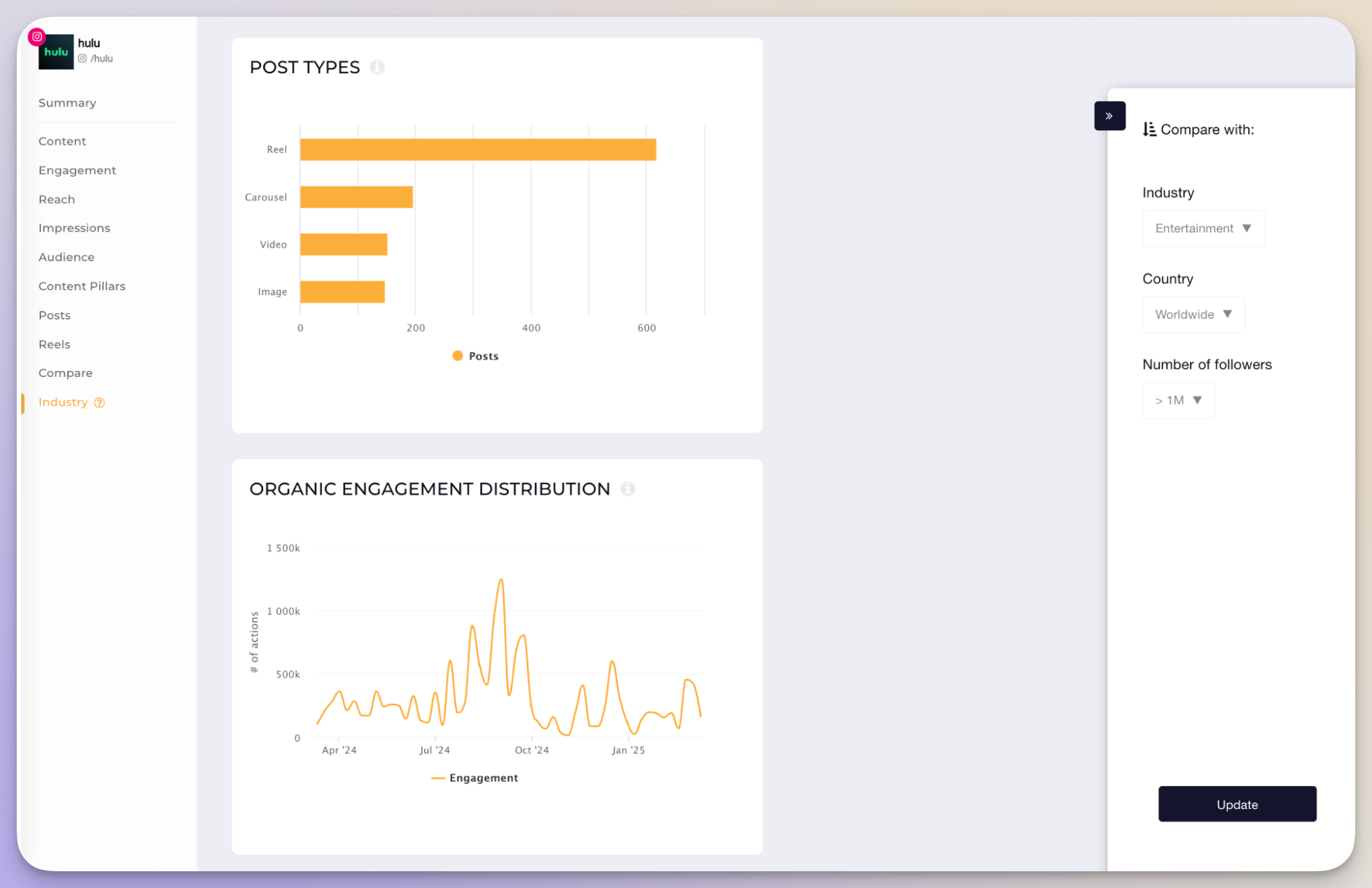
- Audience insights and demographics: Socialinsider breaks down audience data by location, gender, age groups, and activity patterns, allowing for more targeted content and campaign planning.
- Comprehensive reporting and insights: Generates presentation-ready reports with custom branding, filters, and data segments. You can choose to add executive summaries for stakeholders or in-depth performance breakdowns for team members.
- Content analysis and content tagging: You can tag your content to evaluate the performance of individual posts or campaigns and tag them by theme, campaign, or format. Socialinsider can automatically categorize posts into different content pillars using AI, or you can add custom tags yourself.
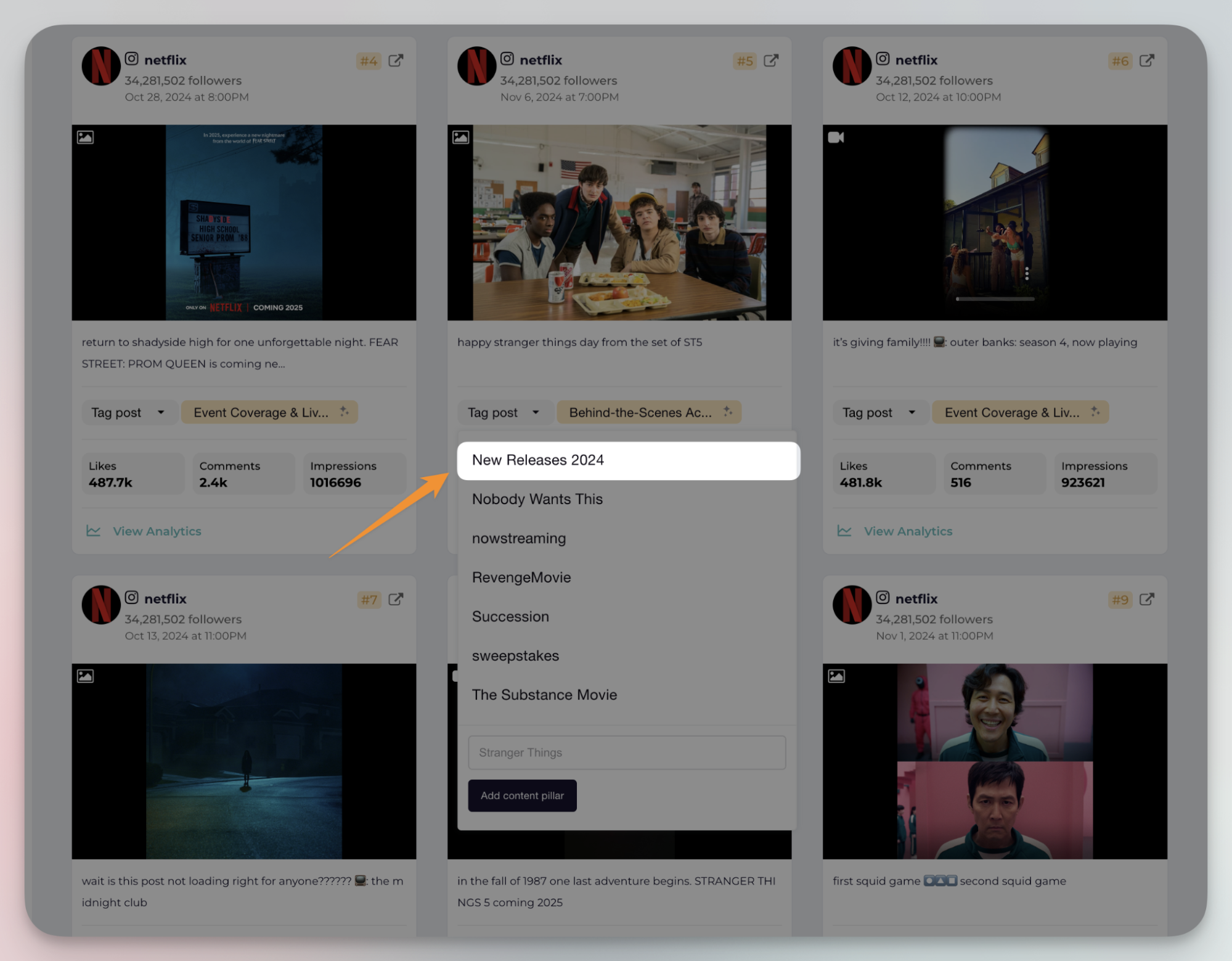
- Cross-platform performance analysis: Socialinsider consolidates metrics from multiple social media platforms into one unified dashboard view, enabling you to compare results across channels and determine where your efforts are most effective. You can group all of a brand’s social media profiles, including Facebook, Instagram, LinkedIn, TikTok, and more, under a single brand for streamlined analysis.
- ROI measurement and attribution: Measures the impact of your organic social content by assigning a dollar value to engagement metrics such as likes, comments, shares, and reach. This ‘organic value’ represents what it would have cost to achieve the same results through paid advertising, helping brands estimate ROI without relying on ad spend data.
- Enterprise-grade analytics features: The tool also offers API access for large-scale data extraction, and provides historical posts data for analyzing trends over long periods.
Limitations
It may not be suitable for teams that don’t require advanced analytics.
Take a look at what the customers have been saying.
What I enjoy most about Socialinsider is that it's much more accurate than SproutSocial and Hootsuite, making the performance presentations and reports that my team gives to my clients more impactful, allowing us to stay true to being a data-driven organization.” - Grady A, Founder & CEO, Small Business
Saves time by having everything in one place. Great for benchmarking, comparisons between brands and quick reports. Socialinsider helped me understand the social media competitive landscape for oil & automotive field and how to improve the content strategy for the Facebook pages my team manage. The app worked smoothly even when I added more than 50 social accounts to monitor.” - Alexandra M, B2B Marketing Expert, Mid Market
Socialinsider has a full feature range that matches many other more expensive tools. The auto-tagging feature is quite helpful as well”. - Christopher G, Mid Market
Best for teams filling gaps in their existing stack
Socialinsider is a strong fit if your current tool doesn’t give you aggregated benchmarks, or makes competitive reporting unnecessarily manual. It’s often brought in to plug those specific analytics gaps without forcing a complete replacement of your existing social media management tools.
All-in-one management platforms
2. Sprout Social
Sprout Social is a social media management platform that combines publishing, engagement, listening, and analytics. While Hootsuite leans heavily on scheduling and basic reporting, Sprout Social pushes further with advanced listening tools, customizable reporting, and enterprise-ready integrations.
Here are the top features of SproutSocial
- Social media management suite: You can plan and publish content across multiple platforms with a visual calendar. The tool also suggests optimal times to publish your content (while Sprout Social claims you can increase reach by 60% using this feature, there’s no data or research available to back this number)
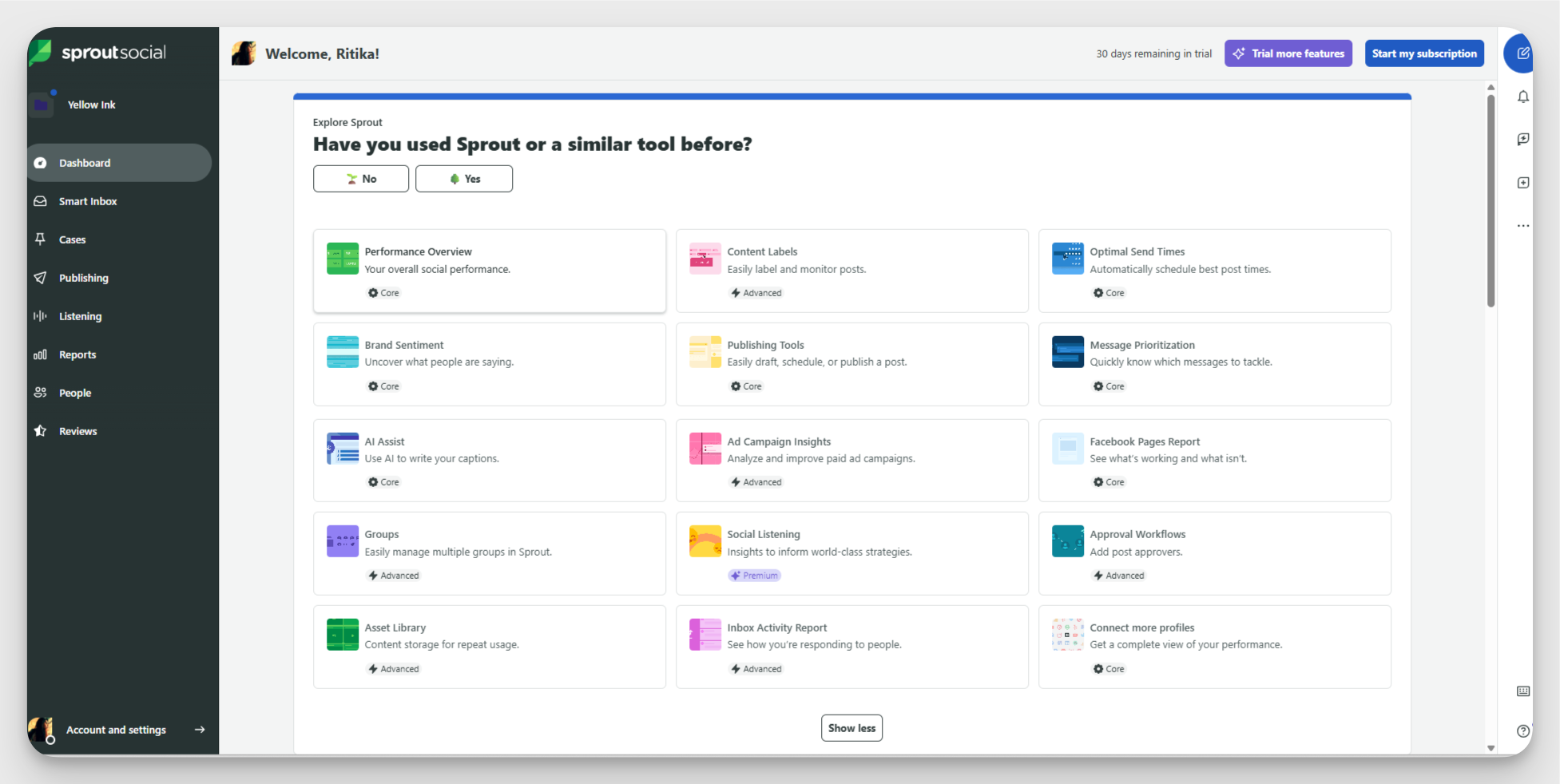
- Social listening and monitoring tools: Sproud Social claims that their tool can sift through ‘billions’ of data points to identify trends and insight. While billions may or may not be the exact number, you can use this feature to spot industry trends early and uncover influencers or brand advocates driving high-impact conversations. Though this is a paid add-on.
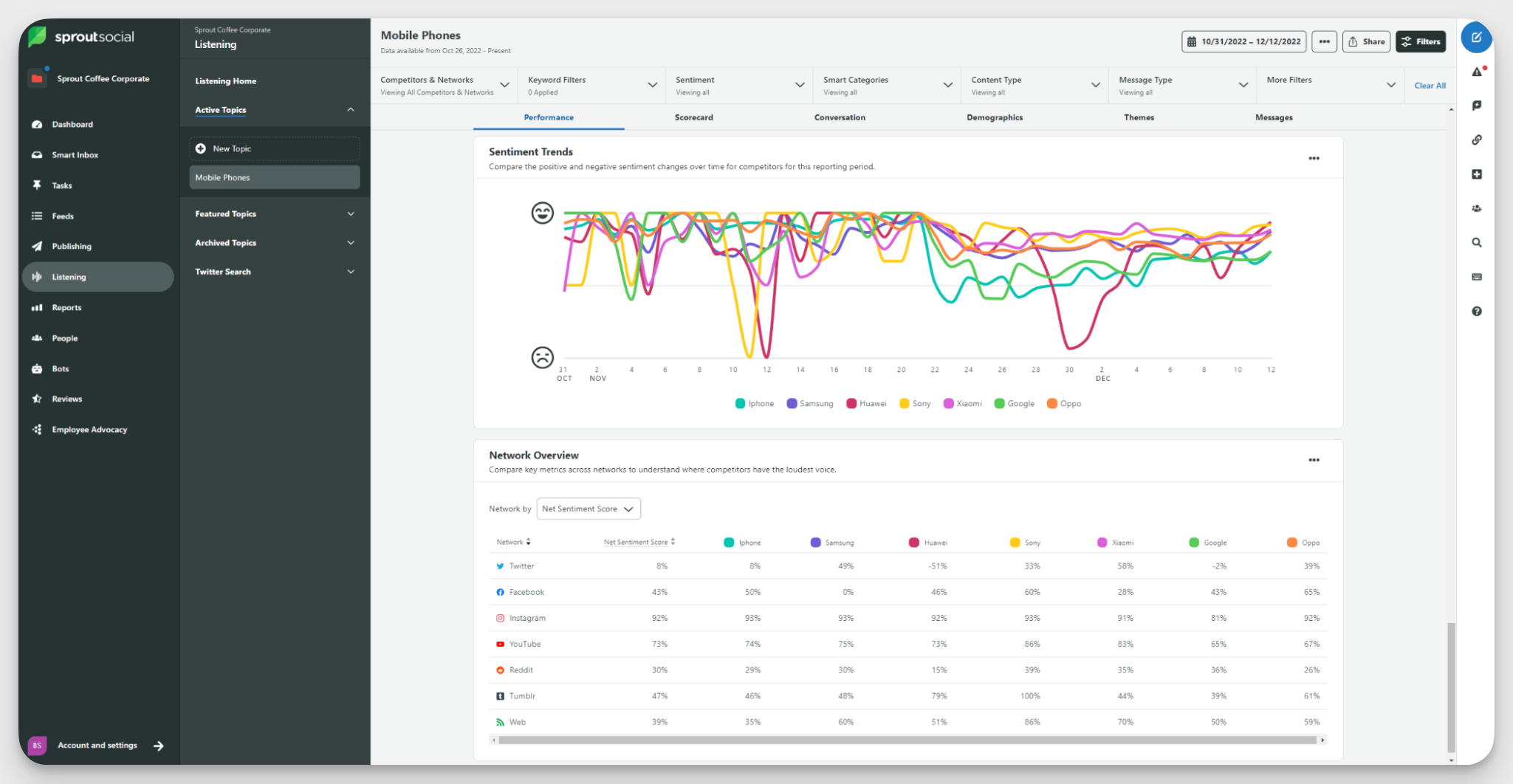
- Team management and collaboration: The Smart Inbox routes messages to the right team member for faster responses.
- Custom report building: Create branded, presentation-ready reports with drag-and-drop widgets. You can also automate recurring report delivery to stakeholders.
Limitations
Sprout Social’s pricing, starting at $199/user/month, can be steep for small teams. Advanced features like deeper listening or competitor analysis are gated behind pricy add-ons. While reporting is highly customizable, a few users feel there’s room for more granular control over dashboards for different audiences or campaign types.
3. Agorapulse
Agorapulse positions itself as an all-in-one tool for publishing, engagement, listening, and analytics. Compared to Hootsuite, it has an edge in social inbox management and CRM integration.
Here are the top features of Agorapulse:
- Social media management suite: Plan and schedule posts across major platforms, including Facebook, LinkedIn, Instagram, TikTok, X (Twitter), and Pinterest. There’s a unified publishing calendar for easy tracking.
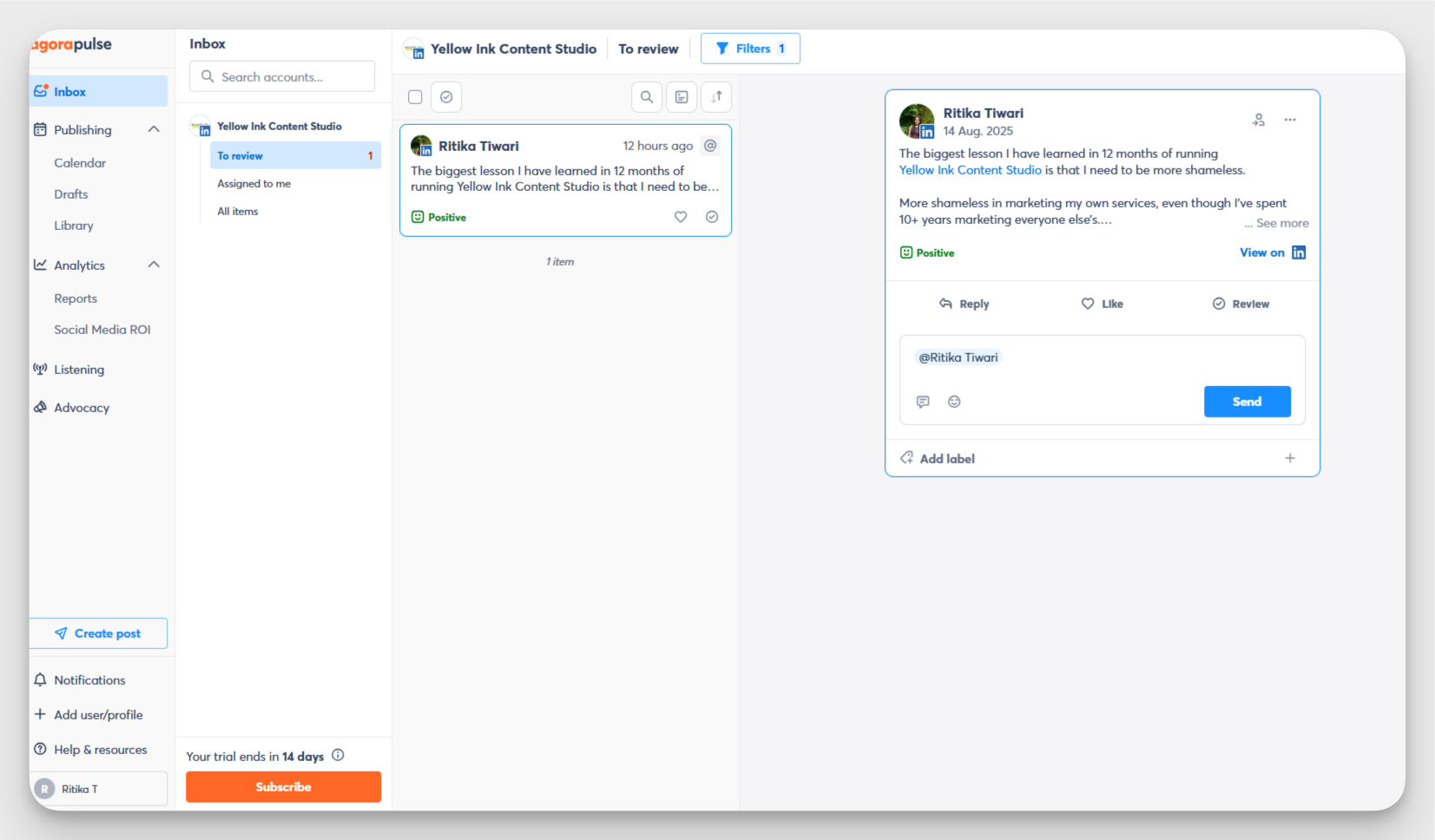
- Social listening and monitoring: You can monitor mentions, keywords, and hashtags across social networks and then filter listening results by language, location, or media type. But here’s the catch: Listening features are only available as an add-on and not part of any of Agorapulse’s main packages.
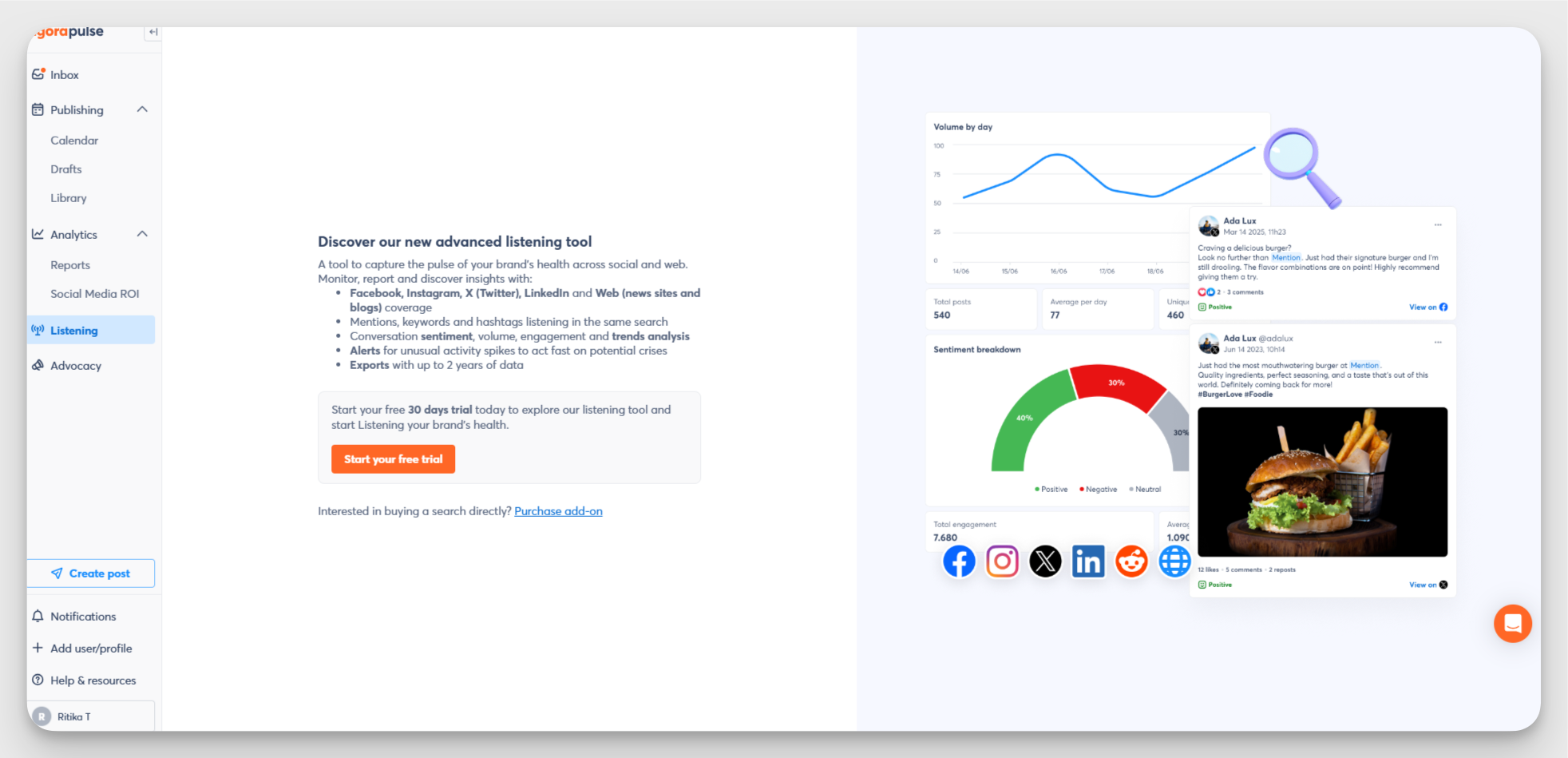
- CRM integration: CRM integration with Salesforce and Hubspot helps you qualify leads on social media, and add them directly to your CRM.
- Team collaboration: The shared social inbox lets your team see all messages, comments, and mentions in one place, assign them to the right person, and reply together.
Limitations
While Agorapulse offers a good set of features, its pricing can be a hurdle for small businesses, especially those that require both social media management and listening support. Some G2 reviewers have shared that the social inbox doesn’t always reflect the comments in real-time. Also, Agorapulse no longer offers X (Twitter) analytics due to API changes.
4. Sendible
Sendible is more focused on offering social media management tools to marketing agencies that manage multiple client accounts. It provides a unified dashboard to organize client accounts, collaborate, and streamline social media content.
Here are the top features of Sendible:
- Agency-focused platform and white labeling: Sendible lets your clients securely link their own social media profiles through a widget. There are no passwords exchanged, and authentication is handled through OAuth 2.0.
- White-label branding: Available as a paid add-on on higher-tier enterprise plans, it lets you resell fully brandable social media tools to clients using your brand colours and your own web domain.
- Content calendar and scheduling tools: The Smart Compose box supports posting to multiple platforms. You can make bulk uploads, schedule content in advance, and even add UTM tags from right within Sendible for easy campaign tracking. It supports most major networks, but Pinterest isn’t one of them, which is a frustrating gap if your clients rely on it.
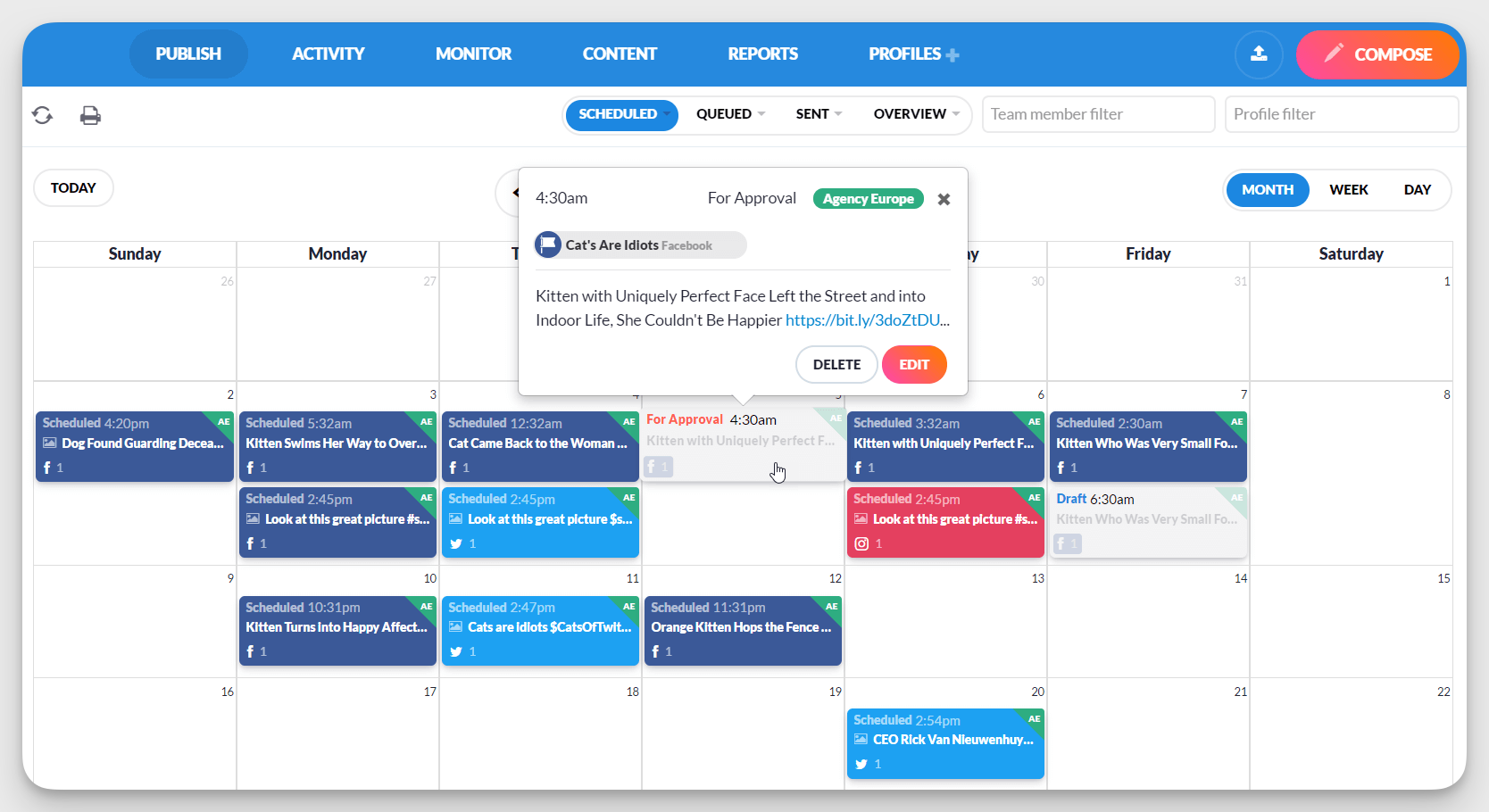
- Team collaboration tools: Role-based permissions and approval workflows help teams collaborate internally and with their clients
- Support for growing agencies: Plans start at $29/month and go up to $750/month for enterprises. It’s flexible for growth, but the fixed user and account limits per plan mean you can’t just add one more seat or social media account without upgrading entirely to a more expensive plan.
Limitations
Several G2 reviewers have pointed out that the platform can glitch from time to time. The rigid user and account caps on each plan can also be a big road bump for many agencies. Overall, Sendible’s features also pretty basic when compared to other tools on the list.
Visual content and creative-first tools
5. Later
Later is more of a visual content planning tool. It started as an Instagram scheduling tool and ‘later’ expanded to support other major platforms, including Facebook, Pinterest, TikTok, YouTube, and X (Twitter).
Here are the top features of Later:
Visual content calendar and planning: Later offers a week- or month-view calendar so you can see all your scheduled posts at a glance. However, each pricing plan has strict schedule posting limits per platform and it's not an overall limit. For example, on the Growth plan, you can schedule up to 30 posts for each platform. Unused credits can’t be reallocated, so if you hit your Instagram limit but never post on Pinterest, those unused Pinterest slots simply go to waste.
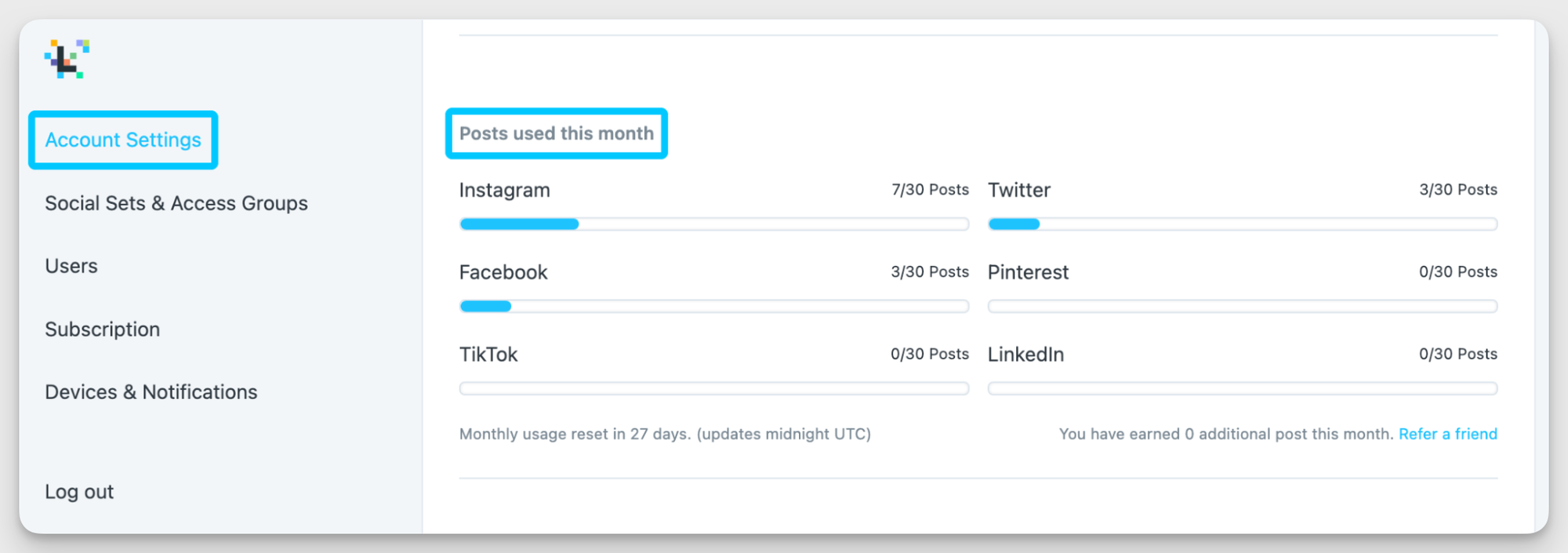
- Instagram-specific features: Later offers Instagram-focused tools like product and location tagging, first comment scheduling, and post automation.
- User-generated content management: You can collect UGC by tracking mentions, tags, or searching relevant hashtags. Later lets you browse contributor profiles, save content to your media library, and repost it with automatic creator attribution.
- Story scheduling and highlights: Later lets you schedule and auto-publish Instagram Stories, which is a rare feature among social media scheduling tools. You can bulk upload media, trim videos, resize images, and add text overlays for Instagram Stories. Although you can't schedule stories with stickers, audio, or other Instagram effects. You also cannot tag users or locations.
- Link in bio optimization: You create a customizable landing page for Instagram, TikTok, and Snap profiles to share all your links together. It's possible to customize the page to match your brand and share individual links for each post/ story.
Limitations
Analytics are fairly basic, with more in-depth insights locked behind higher-tier plans. Video uploads are subject to size restrictions, and collaboration tools are better suited for small teams than larger organizations. Some users note occasional post failures or account disconnects, which can be frustrating for time-sensitive campaigns.
6. Planoly
Planoly is a social media management tool focused on visual planning for Instagram and Pinterest, making it ideal for creators and small businesses that prioritize brand aesthetics.
Here are the main features of Planoly
- Visual planning: Planoly’s drag-and-drop calendar makes it easy to upload, rearrange, and schedule Instagram content with precision. The dashboard, which is essentially a more aesthetic version of Later, can be switched between list, gallery, or grid views.
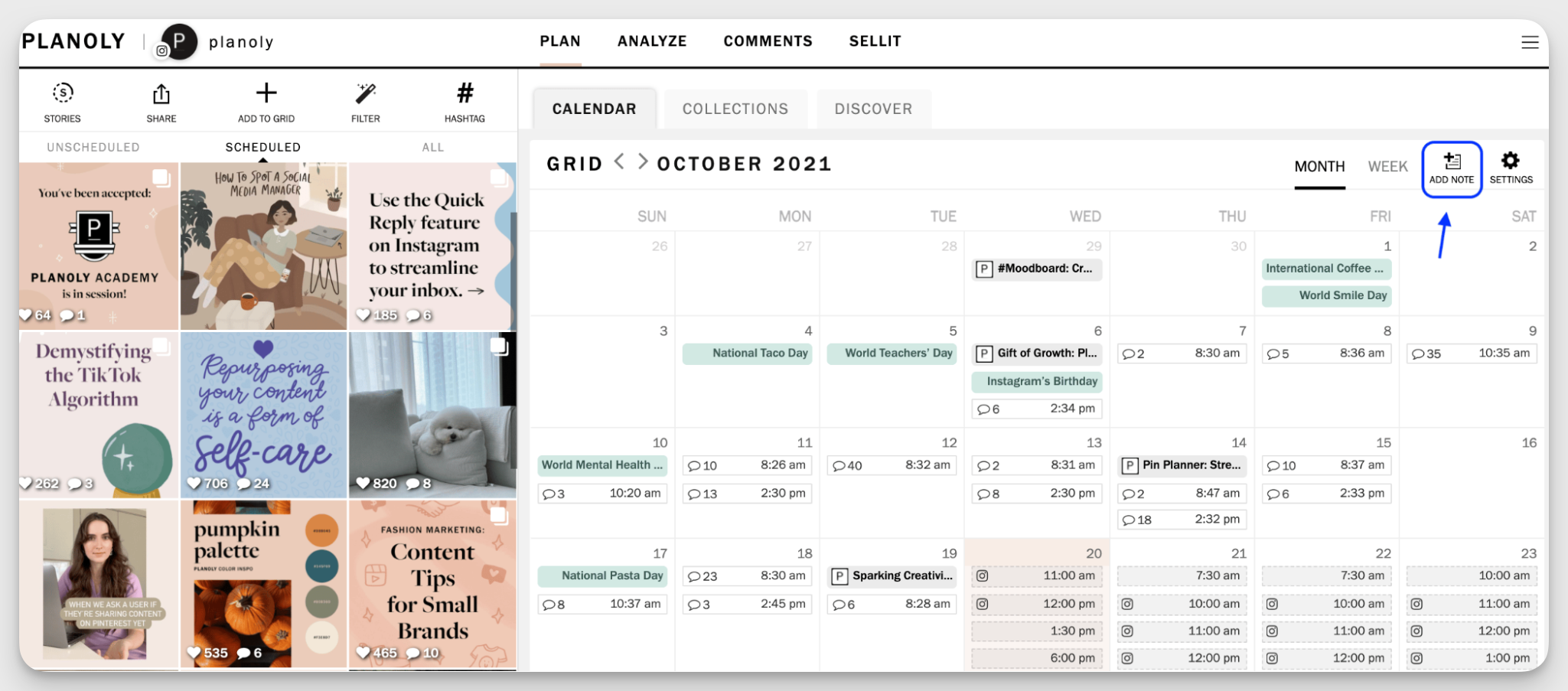
- Instagram and Pinterest specialization: You can plan your Instagram and Pinterest content in advance and schedule posts through Planoly. You can auto-publish Instagram Posts, Stories, and Pinterest Pins, including Idea Pins and Video Pins. However, Instagram carousels and Reels require manual uploads.
- E-commerce integrations and shopping: Planoly integrates with Shopify to let users create a storefront and showcase products directly within their social feeds. E-commerce features are offered under a separate Creator Studio pricing plan, and it doesn’t include social media scheduling features.
- Story planning and highlights: With Planoly, you can upload, plan, and auto-post Instagram Stories at once. Though you can’t auto-post multiple Stories together or add stickers, audio, or other effects.
- Analytics for visual content: Planoly provides basic analytics. The reporting is relatively limited, lacking the in-depth engagement and audience insights found in more advanced social media management tools.
Limitations
Planoly does not include an in-built content approval process, which can complicate team collaboration for larger social media teams. Some users also found the visual planner to be overwhelming, especially when compared to Later's visual planner and media library.
Meta Business Suite
Meta Business Suite (formerly Creator Studio) is a native management tool for Facebook, Instagram, and WhatsApp Business accounts. It is best suited for businesses heavily invested in the Meta ecosystem.
Here are the top features of the Meta Business Suite
- Native Facebook and Instagram management: Meta Business Suite allows you to manage multiple Facebook Pages, Instagram accounts, and ad accounts from one central dashboard.
- Video publishing and optimization: Live broadcasts, Reels, and Stories can be scheduled or published directly through Live Producer. Bulk video uploads aren’t supported.
- Cross-posting capabilities: The platform supports automatic cross-posting of posts, Stories, and Reels between Facebook and Instagram.
- Insights and performance metrics: You get detailed audience analytics, including follower demographics, top cities and countries, follower growth rates, and 1-minute video views. However, historical data retention is restricted, with most metrics only available for the last 28 days.
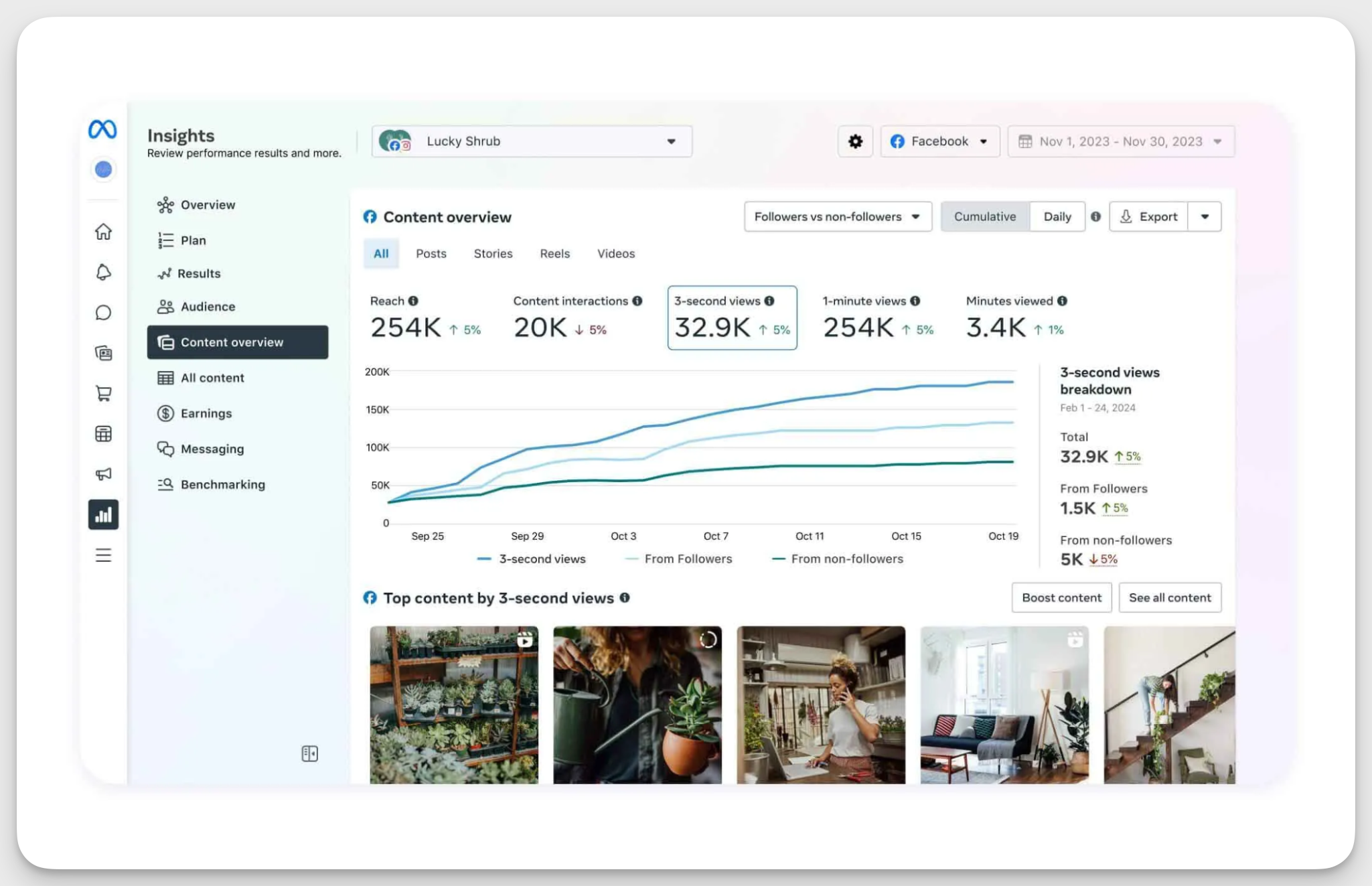
- Direct platform integration advantages: Because Meta Business Suite is a native tool, it offers full access to platform-specific features such as tagging, video monetization, and ad management.
Limitations
Meta Business Suite is limited to managing Facebook, Instagram, and WhatsApp Business accounts, meaning other social platforms must be handled separately through a different tool. Response times from support are slow, and there are minimal options for customizing the dashboard
Marketing workflow and automation
8. CoSchedule
CoSchedule started as a headline analyzer tool, and it has since grown into a full-fledged social media marketing tool with content planning, social media scheduling, and team collaboration features.
Here are the main features of CoSchedule
- Marketing calendar integration: Visualize your entire content strategy in one place, including blog posts, emails, and social campaigns. For agencies, white-label options are available, though these come at an additional cost.
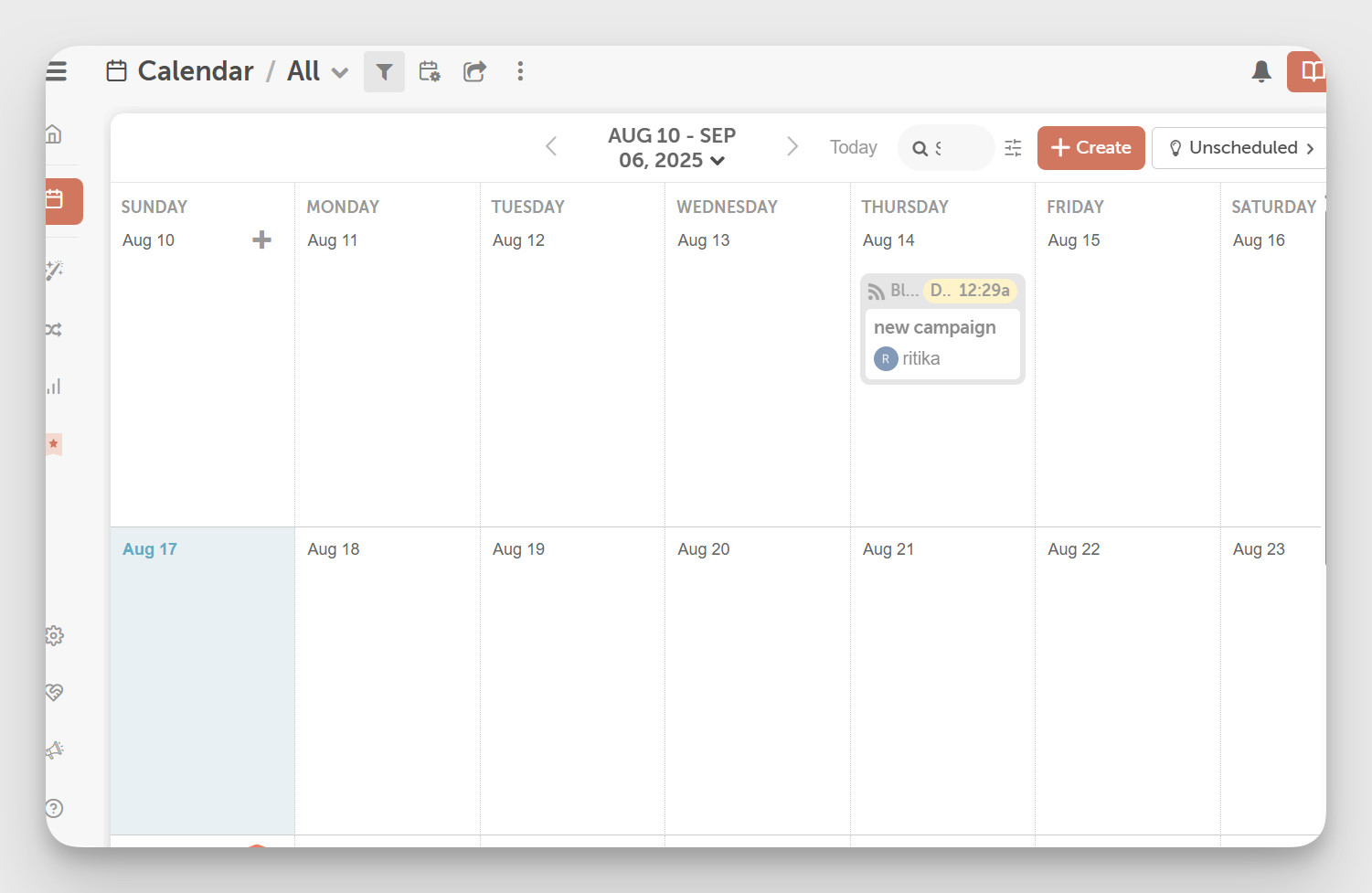
- Content marketing workflow management: All the digital files get stored in the Asset Organizer for easy accessibility. You can also tag projects and use templates to streamline workflows across campaigns.
- Team collaboration: You can invite members, assign projects, and track progress in real time. Advanced user role permissions are reserved for the custom-priced enterprise plans.
- Blog post and social content coordination: The ReQueue feature helps automatically promote popular blog posts and recurring content. But this feature is only available as an add-on.
- Marketing campaign organization: To be honest, CoSchedule’s marketing campaign organization feels unnecessarily complex. It uses a hierarchical structure where every content asset must be tagged into a project, and then multiple projects are grouped into a campaign. Sounds confusing? Because it is.
Limitations
Most of CoSchedule’s useful features, like requeuing content, collaborating through social inbox, and even basic insights, are locked behind higher-tier pricing, which can make the platform costly for smaller teams. Support for Twitter is also now an add-on feature.
9. Semrush
Semrush is primarily an SEO tool that offers social media management as an add-on–available for an extra $20 per month. While its social features are useful, they are secondary to its core SEO and competitive research capabilities.
Here are the top features of Semrush that can help social media marketers:
- SEO-integrated strategy: You can use its core SEO tools to identify high-performing keywords and trending topics, which can then help in content planning. Additionally, you can find competitors targeting similar keywords and evaluate their performance.
- Understand your audience: Gain insights into both your own and competitors’ audiences through Traffic Analytics and Market Trends modules (available at an additional cost). This includes traffic sources, industry benchmarks, and audience demographics.
- Competitive analysis: Semrush supports competitor tracking, but only after you link your own social media profiles. Supported platforms include Facebook, Instagram, YouTube, and Pinterest. LinkedIn, TikTok, and X (Twitter) are not supported.
- Content optimization: You can use Semrush’s AI to generate ideas, posts, images, and videos. But the functionality remains nascent, and the generated AI content really just looks like AI content.
- Unified workflow: There’s a social media content calendar that can be used to schedule and visualize posts across supported platforms.
- Performance tracking: You can track social media performance, but insights are pretty basic, covering engagement, content mix, and posting times. There is no support for deeper analytics or cross-platform comparisons.
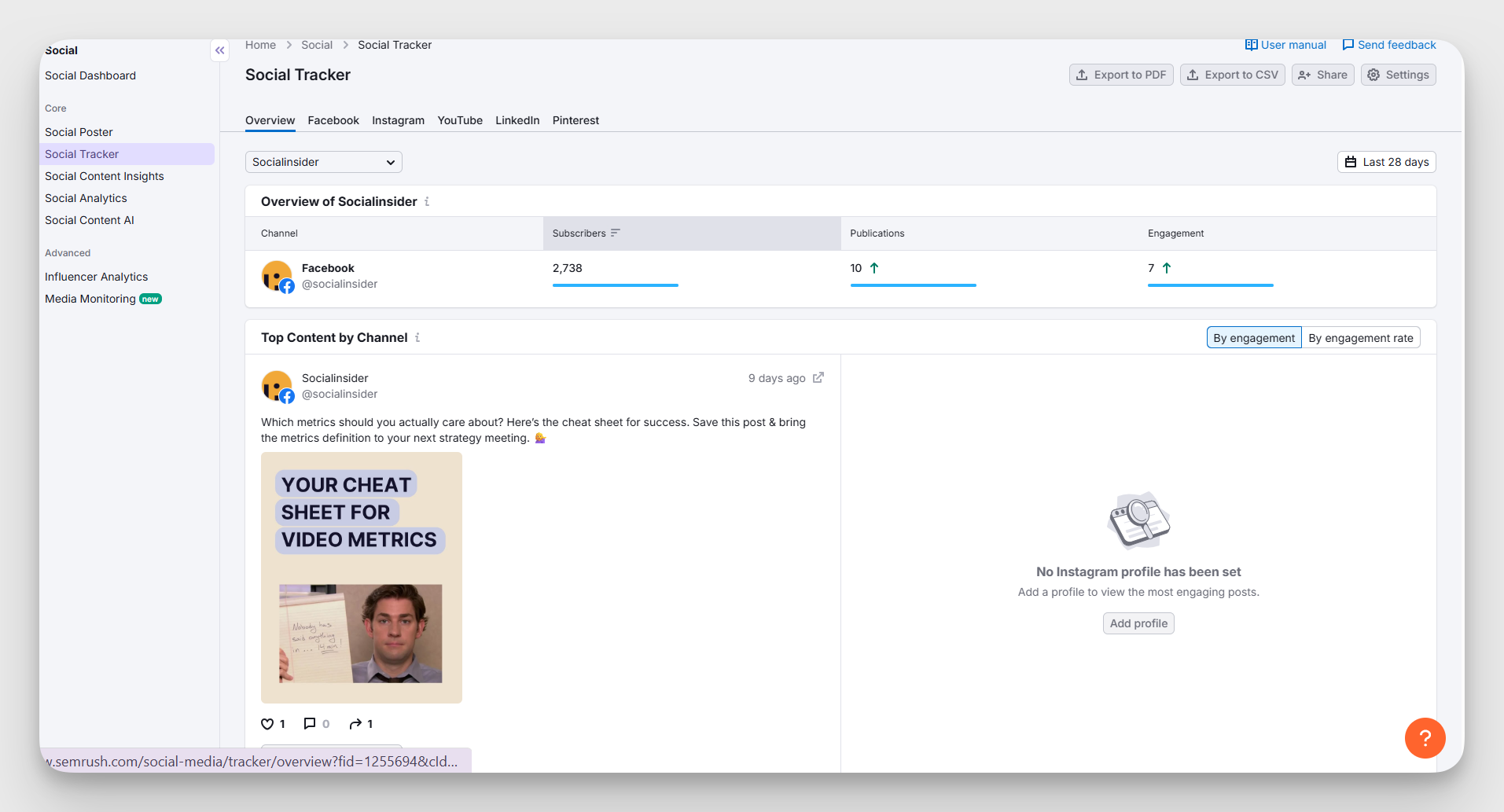
Limitations
LinkedIn is no longer supported, and TikTok and X (Twitter) were never available in the first place. The platform lacks advanced analytics, sentiment analysis, and social listening features. Since social management is offered as a paid add-on, users must spend an additional $20 per month on top of their existing Semrush subscription.
Budget-friendly and startup solutions
10. Buffer (Essentials & Free)
Buffer helps individuals and small teams schedule posts, track engagement, and manage basic analytics across multiple platforms. Compared to Hootsuite, it's definitely lighter on the pocket.
Here are the main features of Buffer
- Free plan with basic features: With the free plan, you can schedule 10 posts per channel every month and get access to basic analytics–ideal for solo users.
- Affordable paid plans for small teams: Paid plans start at $5 per month per channel. They are great for small teams as they offer unlimited scheduling, advanced analytics, engagement tracking, hashtag management, and AI-assisted content generation.
- User-friendly interface: Buffer’s interface is pretty neat–and definitely a lot better to navigate than Hootsuite.
- Essential scheduling and analytics: Scheduling is simple to use, and the tool offers the option to set custom posting times for each day. Once set, these time slots appear in your calendar, and you can quickly fill them. The tool automatically organizes posts in chronological order. Beyond scheduling, the built-in analytics provide helpful insights for small teams, though they’re not as detailed.
- Growth path to advanced features: Buffer supports growth through tiered plans. You can start with the free plan, test the platform, and upgrade as your posting needs, team size, or analytics requirements expand.
Limitations
Some G2 reviewers reported that posts scheduled through Buffer frequently fail. Others have had issues scheduling Instagram posts.
11. SocialPilot
SocialPilot focuses on multi-platform scheduling, reporting, and client management while providing a more affordable alternative to enterprise-heavy tools like Hootsuite.
Here are the main features of Socialpilot:
- Cost-effective multi-platform management: It supports Facebook, Instagram, TikTok, LinkedIn, YouTube, and Pinterest. The pricing is lower than competitors like Hootsuite, despite offering a feature set that’s largely on par with, or in some areas comparable to, what those higher-priced tools provide.
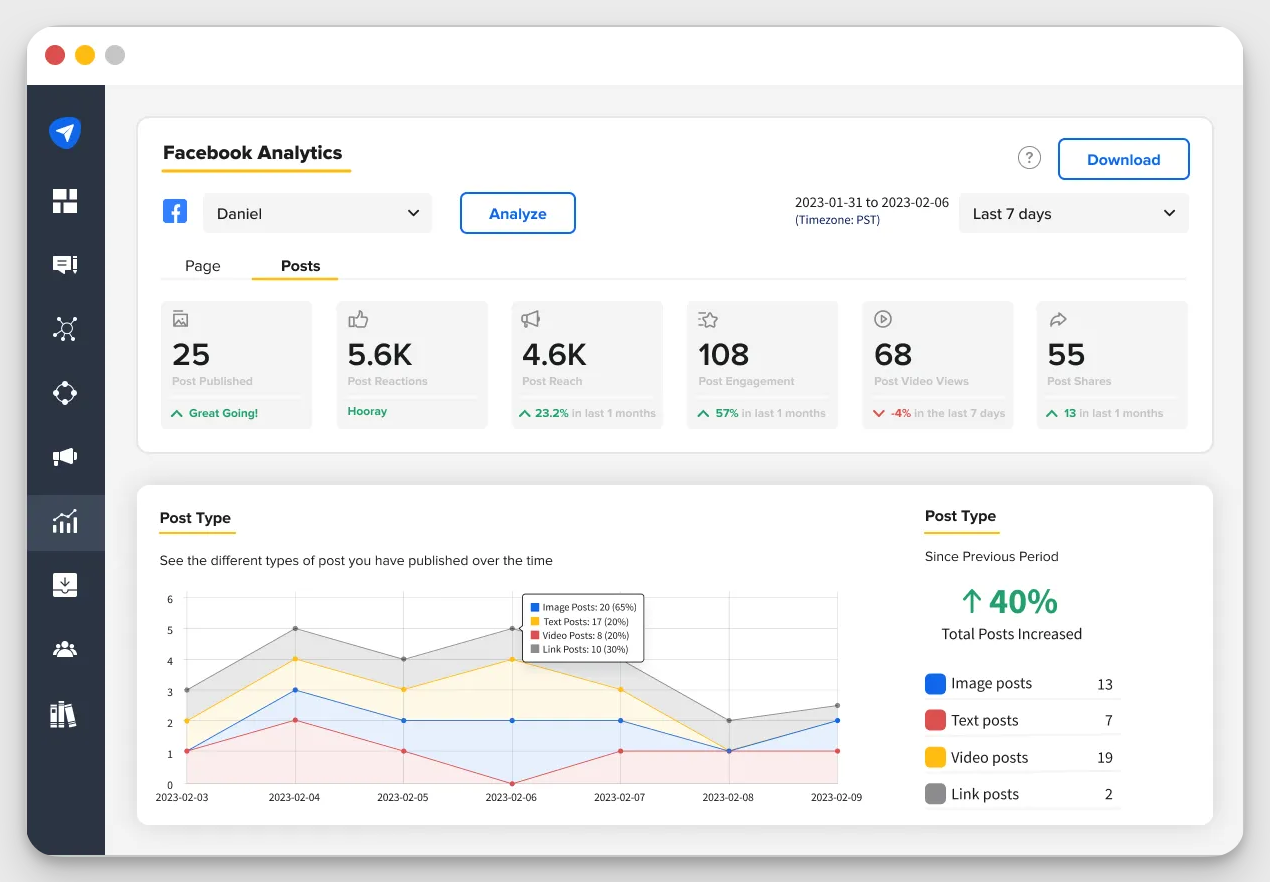
- Bulk scheduling capabilities: You can plan and schedule hundreds of posts at once using a CSV upload. Assign posts to specific accounts, schedule them for optimal times, and even add first comments to boost engagement.
- White-label options for agencies: Agencies can rebrand dashboards and reports with their own logo and colors, and give clients a simple one-page login to share their account credentials.
- Client management features: SocialPilot simplifies client collaboration through personalized invitation links and branded logins. Clients can review and approve posts, access shared content libraries, and receive consolidated performance reports via PDF.
Limitations
While SocialPilot’s starter plan covers many essential features, it lacks features like advanced analytics, team collaboration, and client management.
12. SocialBee
SocialBee streamlines content creation, scheduling, and audience engagement. Pricing is significantly lower than Hootsuite, starting around $29/month, with separate plans for small businesses and agencies.
- Content categorization: You can organize all your posts into distinct folders or categories to build your own content library to quickly find or schedule specific types of content when needed.
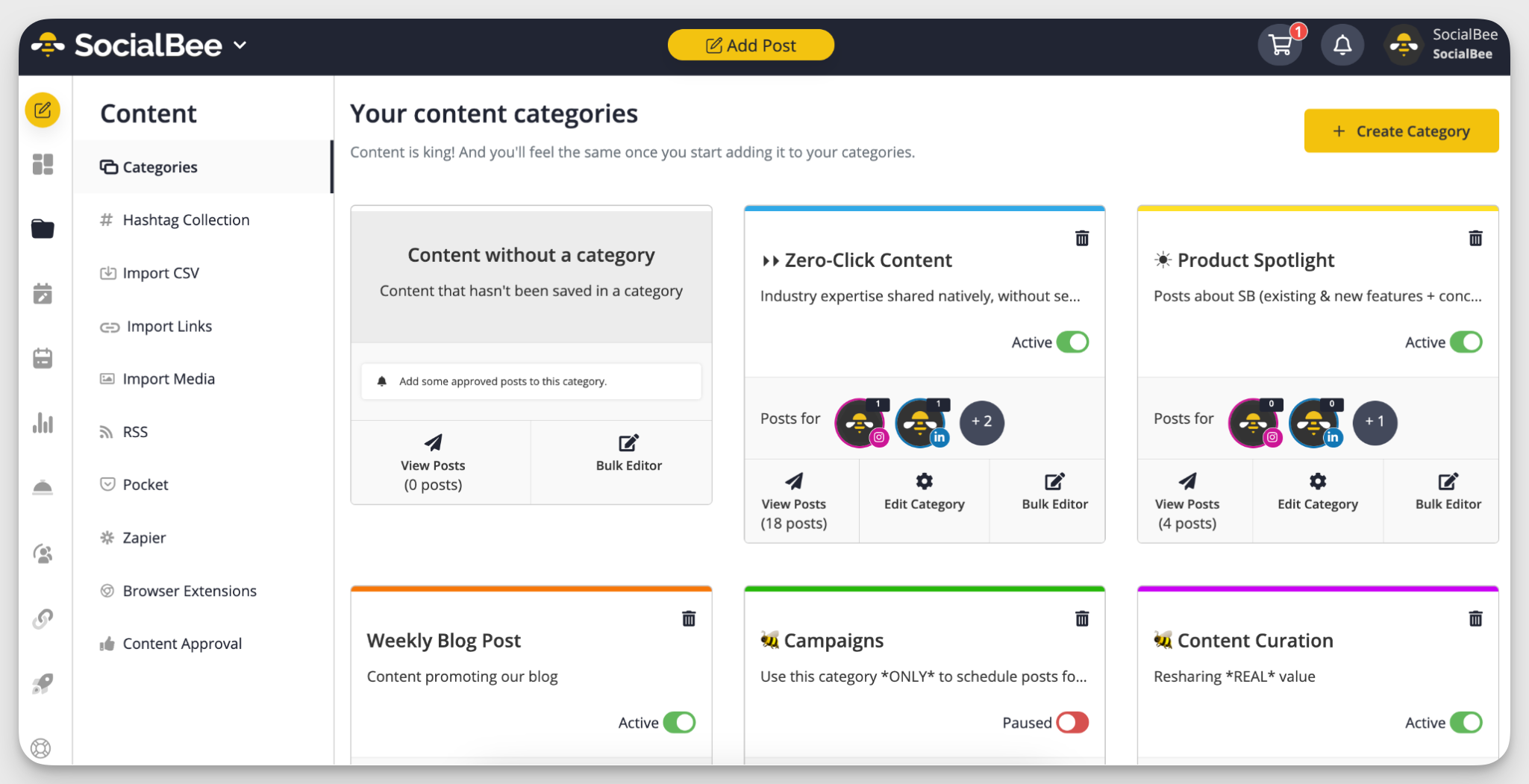
- Recycling of evergreen content: You can requeue individual posts or even recycle entire content categories, ensuring evergreen content continues to reach new audiences. However, a G2 reviewer pointed out that when a category contains a mix of new and recycled posts, controlling the exact order in which they appear can be tricky.
- Audience engagement: SocialBee consolidates comments, mentions, and direct messages from various platforms into a single inbox, simplifying community management and collaboration.
- Content library management: Users can store and organize digital assets like images, videos, and documents in a centralized media library for easy access and collaboration.
- RSS feed integration: SocialBee allows users to import content from various blogs directly into the platform via RSS feeds to automate content creation and publishing
Limitations
Users have also reported occasional glitches, such as issues with profile posting notifications. There is also a huge price jump between their standard and agency plans when the features remain exactly the same. The only difference is the number of accounts and users supported.
Specialized and niche solutions
13. Zoho Social
Zoho Social is designed for businesses and agencies, especially those already using the Zoho ecosystem. It focuses on integrating social campaigns with CRM, lead management, and team workflows, providing a more connected marketing experience.
Here are the top features of Zoho Social
- Integration with Zoho Business Ecosystem: Zoho Social integrates seamlessly with other Zoho tools such as Zoho CRM and Zoho Desk. You can set rules for each social platform to create new leads based on their actions and then sync the leads directly to your Zoho CRM account.
- Team collaboration features: You can assign posts, campaigns, or monitoring tasks to team members. It's also possible to comment internally on scheduled posts to better manage approvals.
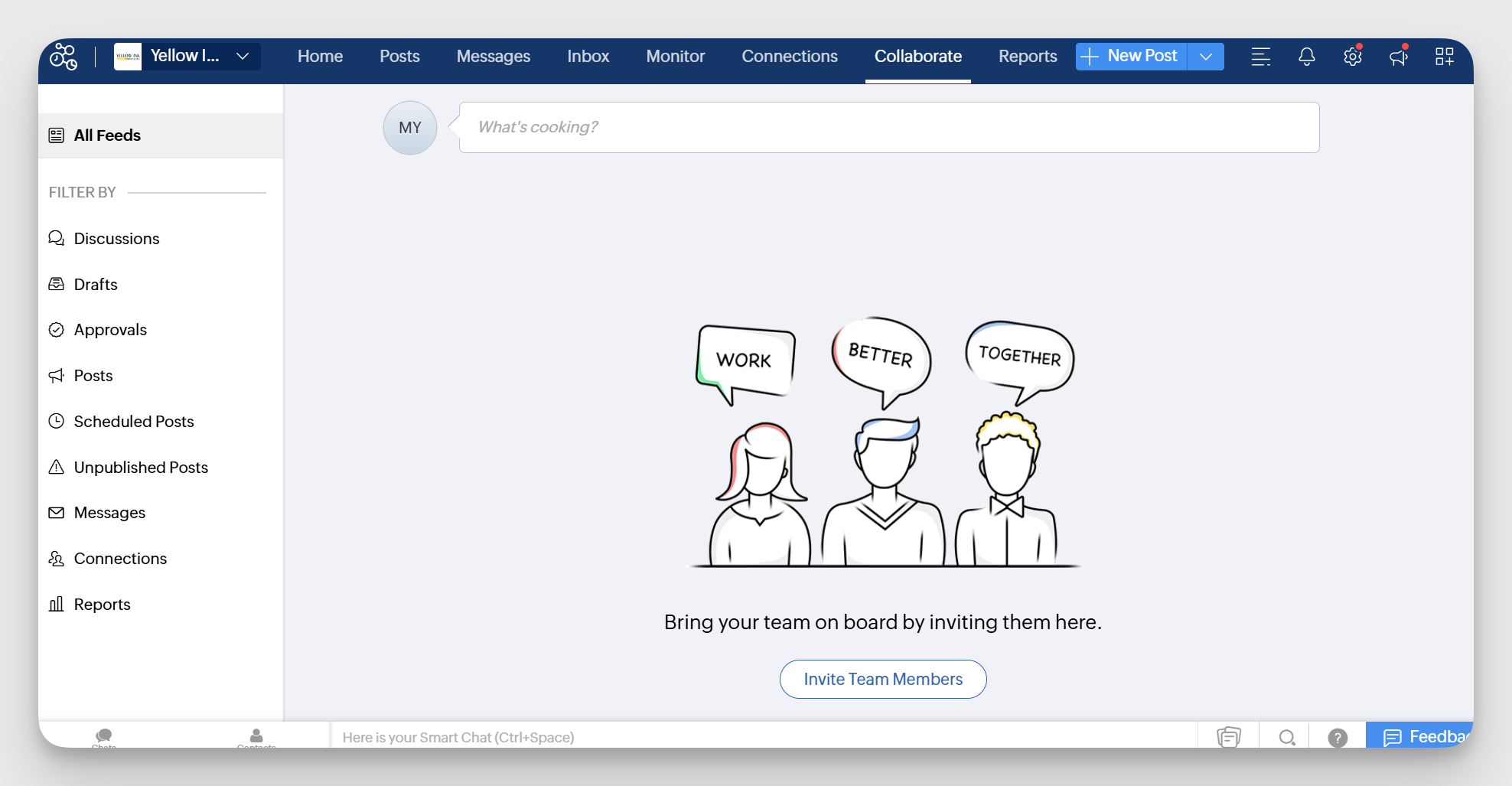
- Social monitoring and listening: You can build a listening dashboard for different keyword searches, mentions, page reviews, hashtags, and more. Though, the listening feature is pretty basic and some users have reported that it lags from time to time.
- Business suite integration advantages: Zoho Social’s main draw is how neatly it plugs into the rest of the Zoho ecosystem. If you already use Zoho’s other tools, that’s great–you can use this tool to keep your social media management under the same roof. But if you don’t, you lose most of this business suite advantage, making Zoho Social less compelling compared to other standalone tools.
Limitations
Analytics are pretty limited and lack advanced features like sentiment analysis or competitor benchmarking. Some advanced scheduling and automation features are locked behind higher-tier plans.
Head-to-head comparisons
Hootsuite vs. Top 5 Alternatives (Detailed)
Hootsuite vs Socialinsider: Comprehensive analytics features comparison
Analytics and reporting
Platform coverage
- Socialinsider: Facebook, Instagram, X, LinkedIn, TikTok, YouTube, offering data for competitors as well
- Hootsuite: Facebook, Instagram, X, LinkedIn, TikTok, YouTube, Threads, Pinterest (Analytics more focused on the accounts you manage)
Pricing analysis
- Socialinsider: Starting at $99/month (analytics-focused)
- Hootsuite: Starting at $99/month (management-focused)
- Winner: Socialinsider for analytics value, Hootsuite for comprehensive management
Best for:
- Choose Socialinsider if: You need advanced analytics, competitive intelligence, or detailed performance insights
- Choose Hootsuite if: You need basic social management across many platforms with team collaboration
Hootsuite vs Sprout: Enterprise feature analysis
The bottom line: Both are enterprise-grade platforms, but Sprout Social offers good reporting analytics, superior user experience and customer support, while Hootsuite has broader platform coverage.
Enterprise features comparison
User experience
- Sprout Social: Modern, intuitive interface
- Hootsuite: Feature-rich, but the interface can feel overwhelming for new users
Pricing comparison
- Sprout Social: $199/month (Standard), $299/month (Professional), $399/month (Advanced)
- Hootsuite: $99/month (Professional), $249/month (Team), and custom pricing for Enterprise plans
Migration difficulty
- From Hootsuite to Sprout Social: Moderate (2-3 weeks)
- Data export: Both platforms offer CSV export capabilities
Best for:
- Choose Sprout Social if: You prioritize user experience, customer support, and built-in advanced analytics
- Choose Hootsuite if: You need white-label options and enterprise-grade social listening capabilities
Hootsuite vs Buffer: User experience and pricing
The bottom line: Buffer wins on simplicity and pricing, while Hootsuite offers more advanced features.
User experience comparison
Feature depth
- Buffer: Focus on core scheduling and basic analytics
- Hootsuite: Comprehensive feature set with advanced capabilities
Pricing breakdown
Total cost of ownership (Annual)
- Buffer: $60-$180/year, depending on plan
- Hootsuite: $1,188-$8,868/year depending on plan
Best for:
- Choose Buffer if: You're a small business or solo marketer prioritizing simplicity and cost
- Choose Hootsuite if: You need advanced features and can justify the higher cost
Hootsuite vs AgoraPulse: social listening comparison
The bottom line: Both platforms now offer strong social listening capabilities–Hootsuite through its Talkwalker acquisition, brings enterprise-grade listening, while Agorapulse provides better social inbox management and CRM integration.
Social listening capabilities
Engagement management
- Agorapulse: Unified inbox with advanced filtering and assignment, which is excellent for daily engagement
- Hootsuite: Multiple streams with Talkwalker integration, which is better for strategic monitoring
Reporting on social listening
- Agorapulse: Comprehensive listening reports integrated with engagement metrics
- Hootsuite: Enterprise-grade analytics with Talkwalker's advanced reporting capabilities
Platform coverage
- Agorapulse: Facebook, Instagram, Twitter, LinkedIn, YouTube, TikTok
- Hootsuite: 35+ platforms plus 30+ million online sources through Talkwalker
Pricing considerations
- Agorapulse: Social listening is not included in standard plans; it’s a paid add-on.
- Hootsuite: Advanced listening features require higher-tier plans or Talkwalker add-ons.
Best For:
- Choose Agorapulse if: You need integrated social listening along with more advanced engagement and CRM features
- Choose Hootsuite if: You need enterprise-grade social listening with global coverage and advanced analytics
Hootsuite vs Later: visual content management
The bottom line: Later excels at visual content planning and Instagram management, while Hootsuite offers broader platform support and team features.
Visual Content Features
Instagram-specific features
- Later: Instagram-first platform with specialized tools
- Hootsuite: Instagram supported, but no specialized features available
Content library management
- Later: Visual-first content organization
- Hootsuite: Text-based content library with basic visual support
Team collaboration
- Later: Basic team features with approval workflows
- Hootsuite: Advanced team management and permissions
Best For:
- Choose Later if: Instagram is your primary platform and visual content is crucial
- Choose Hootsuite if: You need comprehensive multi-platform management
Specialized comparisons
Best for analytics and competitive intelligence
Winner: Socialinsider
Why Socialinsider leads:
- Competitive benchmarking: Track competitors' performance, content strategies, and audience growth
- Social media analytics data and API: Create tailored reports for different stakeholders using Looker Studio or Socialinsider API
- Content analysis: Analyze your content performance and set up content pillars for extended analysis
- Industry insights: Compare performance against industry averages and trends
- Advanced attribution: Understand which social efforts drive real business results
- Real-time monitoring: Get instant alerts on competitor activities or performance changes
Runner-up: Sprout Social
- Good for analytics, but limited competitive intelligence
- Excellent user experience for data visualization
- Good integration with business intelligence tools
Hootsuite's position:
- Basic analytics suitable for small businesses
- Requires expensive add-ons for advanced features
- Limited competitive intelligence capabilities
Best for visual content management
Winner: Later
Why Later wins:
- Visual-first design: Built specifically for visual content planning
- Instagram first: Deep Instagram features and optimization
- Content discovery: Tools for finding and organizing visual content
- Mobile-first approach: Excellent mobile apps for content creators
Runner-Up: Planoly
- Similar visual strengths with a Pinterest focus
- Good e-commerce integrations
- Limited platform coverage compared to Later
Best for agencies and client management
Winner: Agorapulse
Why Agorapulse excels:
- Client reporting: Comprehensive white-label reports
- Team management: Advanced role-based permissions
- Multi-client dashboard: Manage multiple clients from a single interface
- Approval workflows: Streamlined client approval processes
Strong Alternatives:
- SocialPilot: Most cost-effective for agencies
- Sendible: Strong white-label options
- Hootsuite: Extensive platform coverage but higher cost
Best for content automation
Winner: SocialBee
Why SocialBee Leads:
- Content categorization: Organize content by type and audience
- Evergreen recycling: Automatically repost high-performing content
- RSS Integration: Auto-post from blog feeds and news sources
- Content variations: Create multiple versions of the same message
Best for budget-conscious businesses
Winner: Buffer
Why Buffer Wins:
- Transparent pricing: Clear, simple pricing structure
- Free plan: Genuinely useful free tier
- Gradual scaling: Easy to upgrade as business grows
- No hidden costs: Features included in stated price
Runner-up: SocialPilot
- Excellent value for money
- Good feature set at a competitive price
- Strong bulk scheduling capabilities
Best all-in-one alternatives
Winner: Socialinsider
Why Socialinsider tops the List:
- Comprehensive Analytics: Industry-leading analytics and insights
- Competitive Intelligence: Unique competitor tracking capabilities
- Cross-platform analysis: All major platforms covered
- Content analysis: Content tagging and content pillars analysis
- Business Intelligence: Advanced reporting and ROI measurement
- Scalability: Grows with enterprise needs
Runner-Up: Sprout Social
- Clean analytics dashboard
- Solid overall interface
- Strong customer support
- Lacks competitor benchmarking depth
- Higher price point but comprehensive capabilities
Hootsuite's position:
- Broad platform coverage
- Established market presence
- Higher total cost of ownership
- Basic analytics only
Decision framework summary
Choose Socialinsider if:
- Analytics and competitive intelligence are priorities
- You need advanced ROI measurement
- Competitor tracking is essential
- You want comprehensive cross-platform insights
- Budget allows for premium analytics features
Choose Sprout Social if:
- You need advanced social listening and trend detection
- You want custom, branded reports with automation
- Team collaboration and Smart Inbox routing are priorities
- You value strong customer support
- You can budget for $199+/user/month or even higher tiers in case you need advanced analytics
Choose Buffer if:
- You need a low-cost, transparent pricing model
- You’re a solo user or small team
- Ease of use is more important than advanced analytics
- Quick setup and implementation are important
Choose Agorapulse if:
- You’re an agency managing multiple clients
- You need strong approval workflows and white-label reports
- You can live without built-in X/Twitter analytics
- You’re okay with paying extra for advanced social listening
Choose Later if:
- You’re an agency managing multiple clients
- Approval workflows and reporting are critical
- You can live without built-in X/Twitter analytics
- You’re okay with paying extra for social listening
- Mobile-first approach appeals to you
The key is matching your specific needs, budget, and growth plans with the tool's strengths rather than trying to find a perfect all-in-one solution.
4 Steps for migrating from Hootsuite to an alternative social media tool
Step 1: Identify your primary category
Define your business size, platform priorities, and team structure. You absolutely shouldn’t end up in a position where you’re paying for features you’ll never touch. If you’re switching because your current tool doesn’t have certain features, make them non-negotiable in this step and confirm that any new tool you shortlist can check off all the requirements.
Step 2: Review specific recommendations
Use our decision framework to match tools to your needs, not just to what’s popular.
Step 3: Consider implementation requirements
Check setup complexity, integrations, and training needs before you commit.
Step 4: Plan your transition
Test all the features and workflows with free trials, set a migration timeline, and track progress against clear success metrics.
Migration guide: switching from Hootsuite
- Pre-migration checklist: Audit all social accounts, identify content libraries, note scheduled posts, and list all active integrations. Also confirm that all critical channels that were missing or partially supported in your old tool can be added, authenticated, and benchmarked in your new platform.
- Data export and import processes: Look into the main options for exporting your current posts, analytics, and media assets from Hootsuite. Use CSV uploads or native migration tools wherever possible to maintain continuity.
- Team training considerations: Don’t skip onboarding. You should get your team comfortable with the new interface and approval flows early.
- Timeline and rollout strategies: Use a phased rollout to migrate accounts and campaigns gradually. Test on a smaller set of accounts before going all-in to avoid chaos.
- Common challenges: Expect issues like broken integrations or failed imports at the start. Make sure to plan out troubleshooting steps and assign team members to each step.
Advanced features breakdown
As your brand scales, the basic features like scheduling and publishing may not cut it. Here are some advanced capabilities that you should consider.
- AI and automation capabilities: AI can generate ideas, optimize send times, and streamline repetitive tasks so your team focuses on strategy, not admin work.
- Advanced analytics and reporting: Look for campaign ROI tracking, competitor benchmarking, and automated reports that give stakeholders more than vanity metrics.
- Social listening and monitoring: A solid tool should track brand mentions, sentiment changes, and competitor moves across multiple sources, helping you spot risks and opportunities before they blow up.
- Influencer management tools: If influencer campaigns are part of your mix, you’ll need features that help you find credible partners, manage collaborations, and tie their impact back to conversions.
- Custom branding and white-label options: Agencies should look for platforms that can deliver polished, on-brand dashboards without making clients log into another tool.
- API access and developer tools: As your workflows get more complex, APIs become critical. Choose tools that integrate with your CRM or project stack, and give you the flexibility to automate what slows you down.
Customer support & training comparison
Great features won’t matter if you can’t get help when things break. Support quality, training, and onboarding processes are critical when you’re assessing the long-term value of a social media management tool.
- Support channel availability: When your social media posts aren’t getting published on time, you don’t want to be stuck waiting for an email. Look for platforms that offer live chat, email, and phone so you can actually reach a human when it matters.
- Response time analysis: Fast response times reduce downtime, allowing teams to resolve urgent problems without delaying campaigns.
- Training resources and documentation: Detailed tutorials, webinars, and knowledge bases help teams quickly onboard and use features effectively.
- Community and user groups: Active user communities provide peer support, best practice sharing, and problem-solving insights that supplement official support.
- Onboarding process comparison: A guided setup or a dedicated account manager can cut adoption time in half and help teams get productive without weeks of stumbling.
Final thoughts
If analytics and competitive intelligence are your priority, Socialinsider is the clear winner. Unlike Hootsuite’s limited reporting, it offers advanced benchmarking, cross-platform analytics, and audience insights.
Agencies and data-driven teams can track competitors, tag and analyze content, and generate white-label reports. Starting at $99/month, it delivers enterprise-grade analytics without Hootsuite’s complexity, making it the strongest choice for marketers who need deeper insights, not just scheduling.
And if you’re trying to fill critical gaps left by your current tools, like weak competitor benchmarks, then choosing an analytics-first alternative becomes even more important. The right Hootsuite replacement won’t just match what you already have; it will finally give you the full coverage and clean reporting you’ve been patching together manually, so you can walk into stakeholder meetings with answers instead of excuses.
FAQs about Hootsuite alternatives
Is it worth switching from Hootsuite?
The decision depends on your specific needs and current satisfaction level. Consider switching if:
- You're experiencing frequent pricing increases
- Analytics accuracy is a concern
- You need advanced competitive intelligence
- Customer support issues are impacting your operations
- You require specialized features for specific platforms
For most data-driven organizations, the switch to Socialinsider provides significant ROI through improved analytics accuracy and competitive insights.
How long does migration typically take?
Migration timelines vary by platform and organization size:
- Simple migrations (Buffer, SocialBee): 1-2 weeks
- Standard migrations (Sprout Social, Agorapulse): 2-4 weeks
- Complex migrations (Socialinsider, Enterprise platforms): 4-8 weeks
The key is proper planning and parallel operation during the transition period.
What features should I never compromise on?
Essential features that shouldn't be compromised:
- Analytics accuracy: Inaccurate data leads to poor decisions
- Platform coverage: Ensure all your important platforms are supported
- Team collaboration: Critical for organizations with multiple contributors
- Customer support: Essential for resolving issues quickly
- Integration capabilities: Important for workflow efficiency
Can I use multiple tools together?
Yes, many organizations use complementary tools:
- Socialinsider + Buffer: Analytics intelligence with simple scheduling
- Socialinsider + Later: Competitive insights with visual planning
- Sprout Social + Socialinsider: Team collaboration with advanced analytics
This approach can provide best-of-breed capabilities while managing costs.
How do I convince my team/boss to switch?
Build a compelling business case:
- Document current pain points and their business impact
- Calculate the ROI of switching, including time savings and improved insights
- Provide trial results showing improved capabilities
- Present competitive analysis showing strategic advantages
- Highlight customer testimonials from similar organizations
What if I need features from multiple tools?
Consider these approaches:
- Primary platform + specialized tools: Use one main platform with specialized tools for specific needs
- API integrations: Connect tools using APIs or automation platforms like Zapier
- Vendor negotiation: Work with vendors to add missing features
- Phased approach: Start with core needs and add tools as requirements grow
Bonus resources
Free templates: Social media audit checklist
Use this comprehensive checklist to evaluate your current social media performance before switching platforms:
Profile optimization audit
- Profile completeness across all platforms
- Brand consistency in imagery and messaging
- Contact information accuracy
- Link optimization and tracking
- SEO optimization for discoverable profiles
Content performance analysis
- Top-performing content identification
- Content pillar performance evaluation
Engagement rate analysis by content type
- Optimal posting time identification
- Content gap analysis vs. competitors
Audience insights review
- Audience demographics and interests
- Follower growth trends and patterns
- Engagement quality assessment
- Audience overlap analysis across platforms
- Competitor audience comparison
Technical setup assessment
- Analytics tracking implementation
- UTM parameter usage for campaigns
- Conversion tracking setup
- Integration with other marketing tools
- Data export and backup procedures
Migration timeline template
Access our comprehensive 8-week migration timeline template that includes:
- Weekly milestone checkpoints
- Daily task breakdowns
- Risk management strategies
- Success metrics tracking
- Team communication templates
ROI calculator for social media growth
Calculate the potential ROI of switching to a more analytics-focused platform:
Input Variables:
- Current social media budget
- Team hours spent on social media management
- Average conversion value from social media
- Current platform costs
- New platform costs
Output Metrics:
- Time savings from improved efficiency
- Revenue impact from better analytics
- Cost savings from platform optimization
- Total ROI calculation
Success metrics framework
Technical Success Metrics
- 100% posting reliability: All scheduled posts go live successfully
- Data accuracy improvement: Analytics align with platform-native data
- Integration success: All required tools connect properly
- Platform coverage: All important social networks supported
Adoption success metrics
- 95% team adoption: Team members actively using the new platform
- Workflow efficiency: Reduced time for routine tasks
- Feature utilization: Advanced features are being used effectively
- Training completion: All team members are fully trained
Business impact metrics
- Performance maintenance: Social media metrics maintain or improve
- Efficiency gains: 20%+ time savings on routine tasks
- Satisfaction improvement: Team satisfaction score of 8/10 or higher
- ROI improvement: Measurable increase in social media ROI
Get started with Socialinsider
Ready to experience the power of advanced social media analytics and competitive intelligence?
Sign up for Socialinsider and discover why data-driven organizations choose Socialinsider over Hootsuite for strategic social media management.
What you'll get:
- 14-day free trial with full feature access
- Dedicated onboarding specialist
- Custom competitive analysis setup
- Advanced reporting dashboard configuration
- API access for custom integrations
Transform your social media strategy with the industry's most accurate and comprehensive analytics platform.
This guide represents our comprehensive analysis of the social media management landscape as of 2025. Platform features and pricing are subject to change. We recommend conducting your own trials and evaluations based on your specific needs and requirements.
Analyze your competitors in seconds
Track & analyze your competitors and get top social media metrics and more!
You might also like
Improve your social media strategy with Socialinsider!
Use in-depth data to measure your social accounts’ performance, analyze competitors, and gain insights to improve your strategy.





